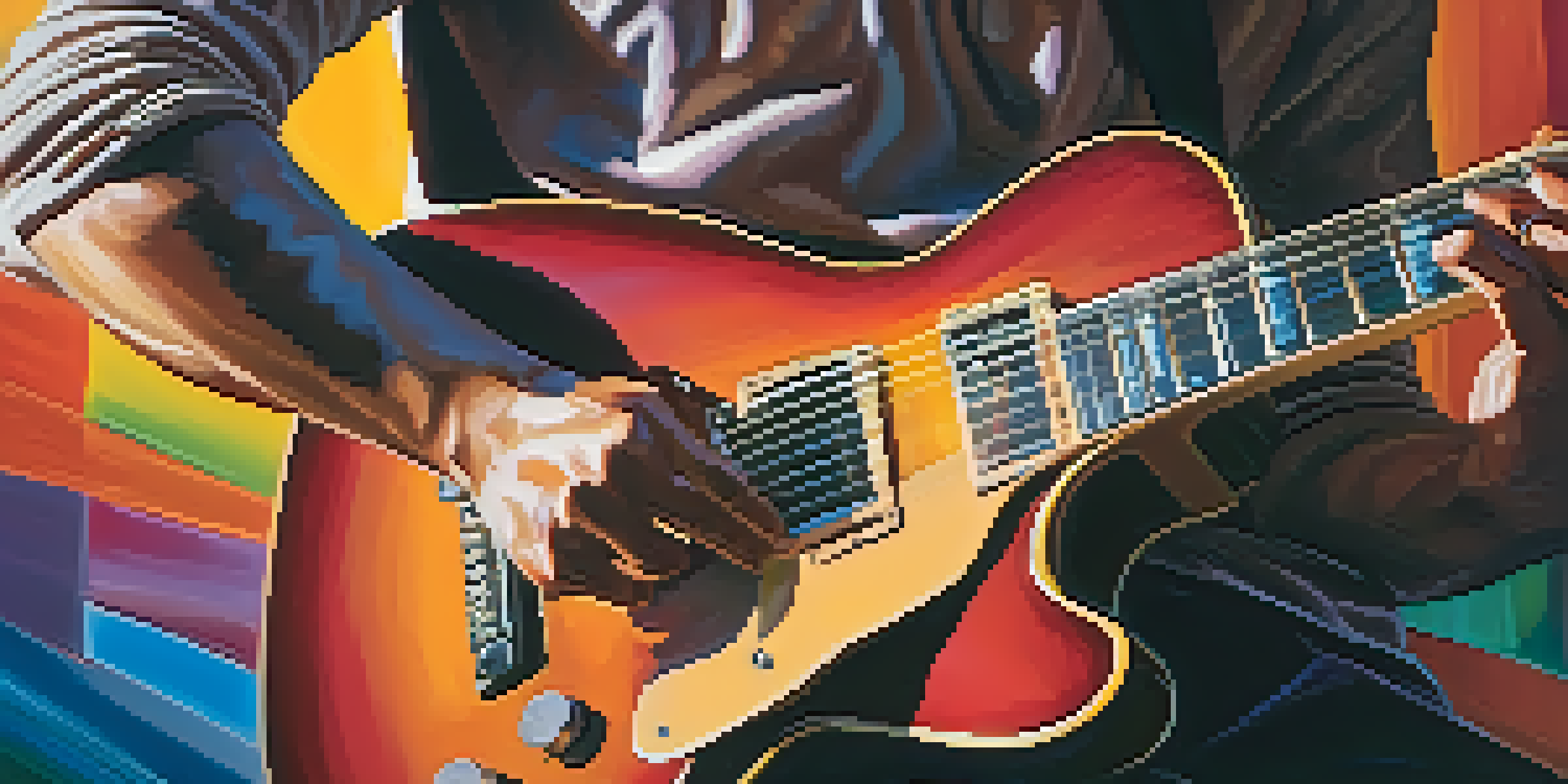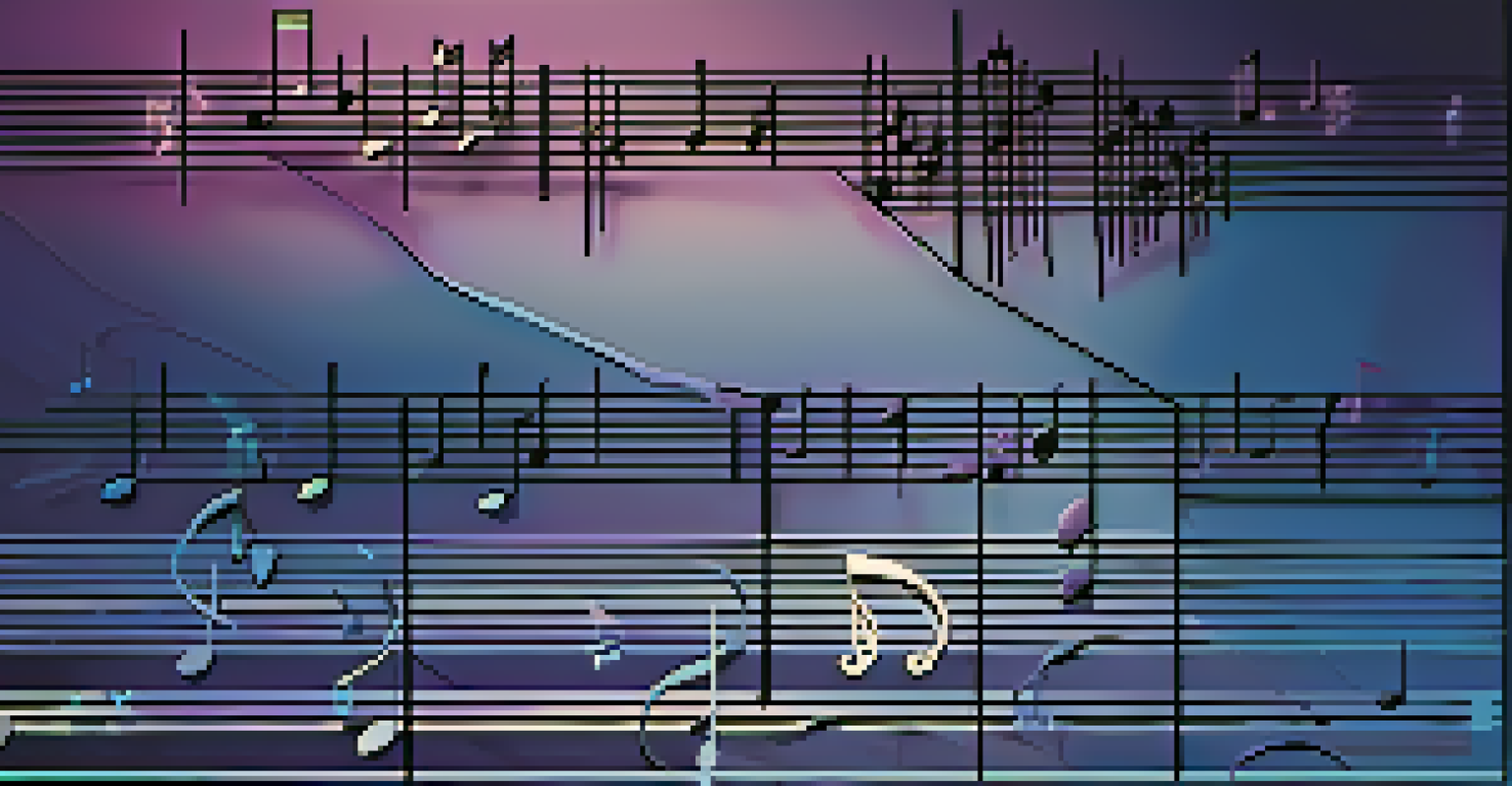Diminished Scales: Unique Patterns for Creative Guitar Solos

Understanding Diminished Scales in Music Theory
Diminished scales are unique musical scales that offer an intriguing blend of tension and resolution. They are built using alternating whole and half steps, creating a symmetrical pattern. This structure allows for a wide range of notes to be played over diminished chords, giving musicians the flexibility to explore complex melodies.
Music is the shorthand of emotion.
In essence, there are two primary types of diminished scales: the whole-half diminished scale and the half-whole diminished scale. The whole-half scale starts with a whole step, while the half-whole scale begins with a half step. This subtle difference creates distinct sonic flavors, which can be utilized to evoke varying emotions in your solos.
Understanding these scales is crucial for guitarists looking to enhance their improvisational skills. By incorporating diminished scales into your playing, you’ll find new ways to express creativity, making your solos stand out in any musical context.
The Construction of Diminished Scales Explained
Constructing a diminished scale may seem complex at first, but it’s quite straightforward once you grasp the pattern. For a whole-half diminished scale, start with a root note and alternate between whole and half steps. For example, starting on C, the scale would progress as C, D, E♭, F, F♯, A, B, and back to C.

Conversely, the half-whole diminished scale begins with a half step. So, if you start on C again, the notes would be C, D♭, E♭, E, G♭, G, A, and back to C. This method of construction not only helps in memorization but also aids in improvisation, as the patterns become second nature.
Diminished Scales Enhance Solos
Incorporating diminished scales can add sophistication and tension, enriching your musical expression.
As a guitarist, recognizing these patterns on the fretboard is key. By practicing these scales in different positions, you can unlock a wealth of opportunities for creative expression during your solos.
How to Use Diminished Scales in Your Solos
Incorporating diminished scales into your solos can add a layer of sophistication and intrigue. One effective way is to use them over diminished chords or dominant seventh chords with altered extensions. This creates tension that resolves beautifully, enhancing your overall musical narrative.
The beautiful thing about learning is that no one can take it away from you.
For instance, if you're soloing over a G7 chord, you might use a D diminished scale. The tension created by the scale resolves nicely when you shift back to notes of the G major scale. This interplay between tension and resolution is what keeps listeners engaged.
Experimenting with phrasing and rhythmic variations while using diminished scales can also yield exciting results. The more you practice, the more comfortable you'll become, allowing you to weave these scales into your solos effortlessly.
Famous Guitarists Who Use Diminished Scales
Many renowned guitarists have skillfully employed diminished scales to elevate their solos. Artists like Allan Holdsworth and John Coltrane have embraced these scales, showcasing their unique sound and technical prowess. Their solos often feature rapid runs and complex harmonies that highlight the versatility of diminished scales.
For example, Holdsworth’s improvisational style frequently incorporates diminished patterns that create an almost otherworldly sound. His ability to seamlessly integrate these scales into his playing serves as an inspiration for many aspiring guitarists.
Two Types of Diminished Scales
Understanding the whole-half and half-whole diminished scales is essential for creating distinct musical flavors.
Listening to these masters can provide valuable insight into how diminished scales can be effectively utilized. By studying their techniques, you can absorb different approaches and find ways to make the scales your own.
Common Mistakes When Using Diminished Scales
While diminished scales can enhance your solos, there are common pitfalls to avoid. One major mistake is overusing the scale, leading to monotonous patterns that detract from the overall musicality. It's essential to find the right balance and utilize the scale judiciously.
Another common error is failing to resolve the tension created by the diminished scale. If you don’t transition smoothly back to the tonal center, the music can feel disjointed. Remember, the beauty of diminished scales lies in their ability to create tension that resolves, so always keep that in mind.
Lastly, neglecting to practice the scales in various contexts can limit your creativity. Make it a habit to explore these scales across different genres and styles, expanding your musical vocabulary and improving your improvisational skills.
Exercises to Improve Your Diminished Scale Skills
To truly master diminished scales, dedicated practice is key. One effective exercise is to play the scale ascending and descending in various positions on the fretboard. This not only builds muscle memory but also helps you become familiar with the unique sound of the scale.
Another useful exercise is to integrate diminished arpeggios into your practice routine. By playing arpeggios derived from the diminished scale, you can create interesting melodic lines that complement your solos. This technique will help solidify your understanding of the scale’s structure.
Avoid Common Mistakes
Being aware of pitfalls, such as overusing the scale or failing to resolve tension, can enhance your improvisational skills.
Finally, consider improvising over backing tracks that feature diminished chord progressions. This will give you a practical application for what you’ve learned, allowing you to experiment with the scale in real-time and develop your personal style.
Conclusion: Embracing Diminished Scales for Creativity
Diminished scales are a powerful tool for any guitarist looking to expand their musical repertoire. By understanding their structure and how to use them effectively, you can elevate your solos to new heights. The unique tension and resolution offered by these scales can bring an exciting dimension to your playing.
As you incorporate diminished scales into your practice, remember to listen and learn from the masters. Their innovative use of these scales can provide valuable lessons in creativity and expression. Don't hesitate to experiment and find your own voice within the scale.

Ultimately, the journey of mastering diminished scales is one of exploration and discovery. Embrace this journey, and you’ll find that your guitar solos become richer, more expressive, and uniquely your own.